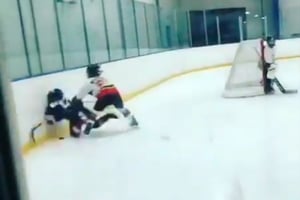Youth hockey is an exhilarating sport that teaches teamwork, discipline, and perseverance. However,...
More Isn’t Better: The Hockey Trap Too Many Parents Fall Into
Think about this scenario: You ask your child if they like candy, and they reply, “Yes, I want candy every day!” Would you give them candy every day? The same logic applies to sports—especially hockey. If you ask your child if they want to skate every day, they’ll probably say, “Yes!” But does that mean you should take them to the rink every single day just because they say they want to?
I hear this all the time: “My kid just loves being at the rink and goes every single day. Practice. Shooting lessons. Skating lessons. Open skating. This tournament here, that tournament there.” As parents, we want to support our kids and provide opportunities to fuel their passion. But at what point does it become too much?
Those who have been involved in this great game for a long time—players and coaches alike—see it all the time: burnout and overuse injuries. It’s a real issue. The problem is, it often becomes serious long before we even realize it’s a problem. As parents, we need to teach our children that too much of a good thing can lead to trouble down the road.
The Need for Boundaries
While it’s wonderful to see children passionate about hockey, parents must recognize the importance of setting limits. Continuous play without adequate rest can lead to burnout, injuries, and a decline in performance. Establishing boundaries helps maintain a balanced lifestyle and ensures young athletes don’t overexert themselves.
Physical Health Benefits
Taking breaks from hockey allows the body to recover and repair. Overuse injuries—such as stress fractures and muscle strains—are common in sports with repetitive movements. Scheduled rest gives muscles and joints time to heal, reducing the risk of long-term damage. Breaks also help prevent chronic fatigue, allowing players to return to the ice refreshed and ready to perform at their best.
Mental Well-Being
Mental health is just as important as physical health—for both players and parents. The constant pressure to perform and the intense focus required in hockey can lead to stress and anxiety. Breaks offer young athletes a chance to relax, engage in other activities, and enjoy time with family and friends. This downtime is essential for mental rejuvenation, helping players maintain a positive attitude and a healthy relationship with the sport. They’ll return to the ice with a newfound appreciation and excitement.
Overall Development
A balanced approach to hockey supports overall development. Engaging in diverse activities fosters creativity, social skills, and cognitive growth. Whether it’s playing other sports, pursuing hobbies, or simply spending time outdoors, these experiences contribute to a well-rounded personality. Parents should encourage their children to explore various interests, helping them build a broad skill set and a resilient mindset. Let’s be honest—most of our children will eventually pursue something other than professional hockey. A well-rounded upbringing helps ease that transition when the time comes.
Financial Savings
Taking breaks from hockey can also lead to significant financial savings. Hockey is known for its high costs—equipment, ice time, travel, and specialized training. Reducing the frequency of these expenses allows families to save money and allocate resources to other important areas. Breaks provide a chance to reassess spending and prioritize essentials, ultimately easing the financial burden of supporting a young athlete’s hockey journey.
Conclusion
While a passion for hockey is admirable, it’s essential for parents to set boundaries and ensure their children take breaks from the sport. This balanced approach promotes physical health, mental well-being, overall development, and financial sustainability—helping young athletes thrive both on and off the ice. By prioritizing rest and recovery, parents can support their children’s long-term success and happiness in hockey and beyond.




